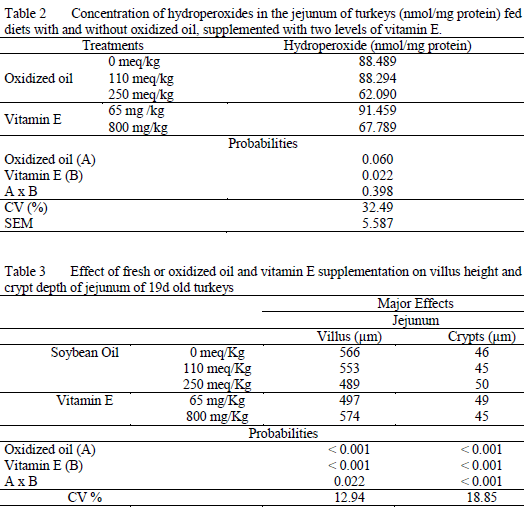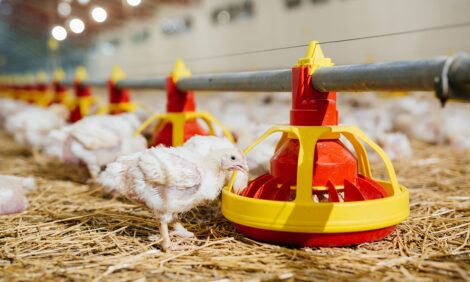



Impact of Quality of Soybean Oil and Vitamin E on the Intestinal Mucosa of Turkeys
The addition of oxidised oil damages the intestinal epithelium of turkeys, and supplementary vitamin E promotes maintenance of the integrity of the intestinal mucosa of the turkeys fed with oxidised oil, according to C. Rocha of the Federal University of Paraná in Brazil and co-authors, speaking at the Australian Poultry Science Symposium 2011.Summary
The addition of oxidised fat in dietary rations may result in damage to the intestinal mucosa, affecting the development of animals.
Because vitamin E has an antioxidant action, it helps to fight against free radicals, preventing the oxidation of lipids. Because of the unfavourable impacts caused by oxidised fat in the diet and the antioxidant properties of vitamin E, the aim of this study was to evaluate the effects of oxidised oil, with or without vitamin E supplementation, on membrane peroxidation and morphometry of the intestinal epithelium of turkeys raised from one to 21 days of age. Five hundred and four male turkeys (BUT 9) were distributed among six treatments, each with six replicates of 14 birds. Fresh or oxidised oil (0, 110, 250meq peroxide per kg oil), with or without additional vitamin E (65 or 800mg per kg fed), was added to the diet. A completely randomized 3×2 factorial design was used.
A significant interaction was observed between the oil oxidation level and the vitamin E level added to the diet and the villus height and crypt depth. The addition of oxidised oil damages the intestinal epithelium of turkeys. Supplementary vitamin E promotes maintenance of the integrity of the intestinal mucosa of the turkeys which are fed with oxidised oil.
Introduction
The gastrointestinal tract of birds is the site of entry of dietary ingredients, being responsible for the functions of digestion, nutrient absorption and body protection.
Oils of vegetable or animal origin are added to diets, to improve the flavour and texture of food, ensure a higher energy density, improve feed conversion and reduce the heat increment (Braga and Baião, 2001). However, the use of fats and oils in animal feed has limitations, because it is an ingredient highly susceptible to oxidation, particularly the lipid sources rich in polyunsaturated fatty acids. This process promotes the formation of free radicals that give rise to compounds such as peroxides, aldehydes, ketones and alcohols that may be detrimental to animal health and production performance. These substances primarily cause disturbances in the mucosa, damaging cellular structures, altering their integrity, compromising the absorption of nutrients and affecting the immune response (Dibner et al., 1996).
To avoid the problem of lipid oxidation, natural antioxidants such as vitamin E (?-tocopherol) can be added to diets. Such compounds can prevent the oxidation process (Batista et al., 2007), minimising the harmful effects of free radicals to the intestinal mucosa to exert a protective effect against peroxidation of phospholipids of plasma membranes and organelles (Batista et al., 2007).
The aim of this study was to evaluate the effects of oil addition with different degrees of oxidation, with or without supplementation of vitamin E on lipid peroxidation and morphology of intestinal mucosa of turkeys.
Materials and Methods
Five hundred and four day-old male poults (BUT 9) were raised in cages and supplied with food and water ad libitum during the experimental period. The birds were allocated to six treatments with six replicates of 14 animals each, totalling 36 experimental units. The design was a completely randomized 3×2 factorial (three levels of oxidised soybean oil and two levels of vitamin E), as shown in Table 1. The diets were isocaloric and isonutrient, from corn and soybeans, with the inclusion of 3.5g per kg of fresh or oxidised soybean oil and met the nutritional requirements recommended for the strain of turkey used.

To study intestinal morphology, five birds per treatment were randomly selected, weighed and euthanized at 19 days old. A 2–cm section of jejunum (2cm from Meckel's diverticulum) was collected for morphological analysis. All samples were opened longitudinally, rinsed with phosphate buffer (0.1M, pH7.4), placed onto cardstock paper and fixed in Alfac solution for 24 hours. Samples were sent to the laboratory for preparation of slides.
Sections 5µm thick were stained with periodic acid-Schiff (PAS). Villi (30) were measured (from the basal region of the villus to its tip, µm) and 30 crypts (from its base to the transition region of the crypt:villus, µm). Villus heights and crypt depths were measured using an Olympus BH2 microscope (Olympus America Inc., NY, USA) and the image analysis program (Motic Images Plus 2.0). To measure the lipid peroxidation of intestinal mucosa, jejunal tissue samples were processed and analyzed according to the methodology described by Sodergren et al., (1998). Data were subjected to analysis of variance at five per cent probability.
Results and Discussion
Supplementation with 800mg per kg of vitamin E in the diet decreased the level of hydroperoxides in the jejunum of turkeys (P<0.05), indicating a lower rate of lipid peroxidation of the intestinal mucosa of these animals (Table 2). The level of oil oxidation did not influence the amount of hydroperoxides in the jejunum of these birds (P>0.05). Also there was no interaction between the factors and level of oxidation level of vitamin E (P>0.05).
There was interaction between the degree of oil oxidation and the level of vitamin E supplementation on villus height and crypt depth of the jejunum (P<0.05; Table 3).
In Table 4 are shown the results of the interaction between the degree of oil oxidation and vitamin E supplementation for villus height and crypt depth. Birds fed diets containing oil with a higher level of oxidation had smaller villus heights than the birds in the other treatments.
According to Yamauchi and Ishiki (1991) when the intestine responds to any agent that causes an imbalance in cellular loss and renewal, there is a change in villus height. However, the treatments containing oil in good condition or with an intermediate level of oxidation did not differ, indicating that the intestinal mucosa of turkeys presents the possibility of recovery of the villi where the animal received a diet containing oil that was oxidised to a moderate extent (110meq peroxide per kg oil).

The supplementation of vitamin E in the diet caused a beneficial effect on villus height. The birds had higher villi were fed diets with extra vitamin E, regardless of the level of oxidation of the oil used. Among the treatments that had the greatest level of vitamin, it was observed that, as the degree of oxidation of the oil increased, the length of villi was lower.

The mucosal damage may increase the maintenance requirement of significantly smaller amounts of available nutrients for animal growth (Dibner and Richards, 2004). As the treatments supplemented with vitamin E showed superior results compared to those without supplementation, it is likely that its antioxidant capacity has neutralized the free radicals and reduced the spread of the chain oxidation process, reducing the damage caused by primary and secondary products of oxidation on the intestinal epithelium.
Conclusions
The presence of oxidised soybean oil in the diet of turkeys had no effect on lipid peroxidation of intestinal mucosa. The supplementation of vitamin E in the diet decreased the production of hydroperoxides in the membrane of the gut and maintained the height and mucosal integrity.
References
Batista E.C.S., Costa A.G.V., Pinheiro-Sant’ana, H.M. 2007. Revista de Nutrição. 20(5): 525-535.
Braga J.P. and Baião N.C. 2001. Cadernos Técnicos de Veterinária e Zootecnia. 31:23-28.
Dibner J.J., Atwell C.A., Kitchell M.L., Shermer W.D. and Ivey F.J. 1996. Animal Feed Science Technology. 62:1-13.
Dibner J.J. and Richards J.D. 2004. Journal Applied Poultry Research, 13:86-93.
Soderren E., Nourooz-Zadeh J., Berglund L. and Vessby, B. 1998. Journal of Biochemical and Biophysical Methods. 37:137-146.
Yamauchi K.E. and Isshiki. 1991. British Poultry Science, 32:67-78.
Further Reading
| - | You can view other papers presented at the 2011 Australian Poultry Science Symposium by clicking here. |
April 2011








